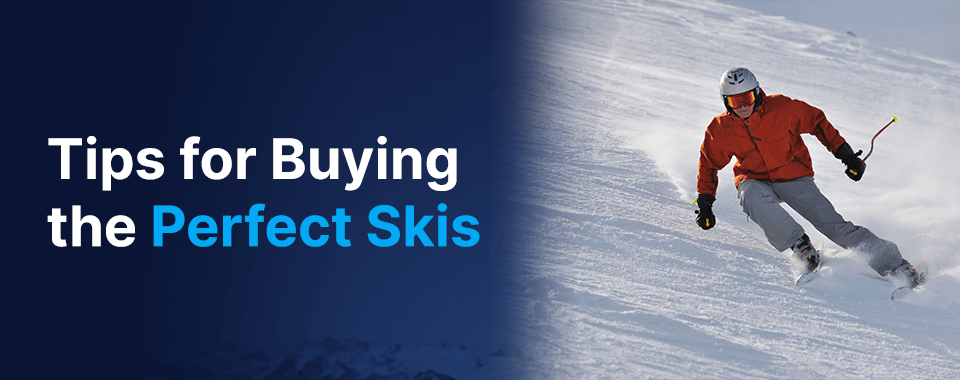 Tips for Buying the Perfect Skis
Tips for Buying the Perfect Skis
Tips for Buying the Perfect Skis
Posted
by
Matt Gahman
on Tuesday, November 1, 2022
There's nothing like ripping down the slopes on a pair of skis — it's the perfect wintertime activity for sporty thrill-seekers. Finding the right pair of skis will make your winter that much more enjoyable. If you're new to skiing, it may surprise you how many choices you have. Knowing what to look for will allow you to pick out the best skis for ski season. Use this buying guide to find the best skis for the upcoming winter.
7 Tips to Buy New Skis for Ski Season
Many different elements will impact your skis' capabilities. Following these tips to update your current skis or buy your first set will help you make the right choice. Here are some factors to consider when buying skis:
1. Skill Level
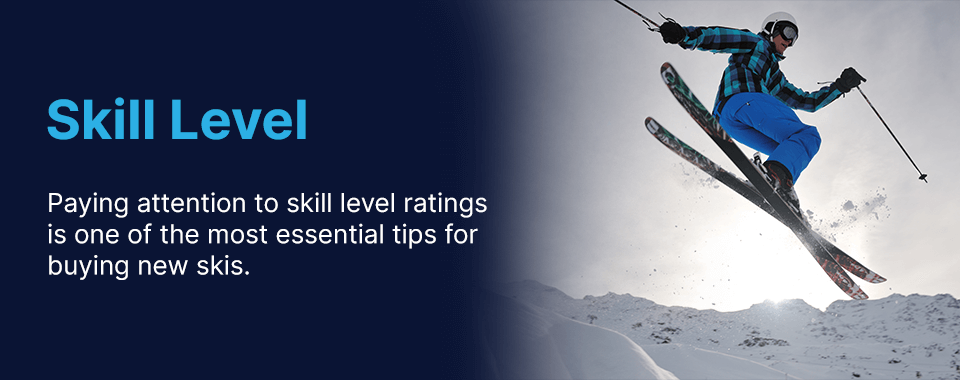
Paying attention to skill level ratings is one of the most essential tips for buying new skis. Beginner-level skis are softer and more forgiving of technical mistakes. In contrast, advanced skis are stiffer, allowing you to apply greater force but leaving little room for error. You should also factor in your weight when choosing a skill level — heavier skiers may want to move up a skill level since more advanced skis can handle greater force.
You'll find skis with a soft, medium or stiff flex rating. Skis are available at the following skill-level ratings:
- Beginner.
- Intermediate.
- Advanced intermediate.
- Advanced.
- Expert.
2. Waist Width
Various waist widths work best in different conditions. Skis with skinnier waists are quicker, which makes them well-suited for trail carving. Beginners should choose skinny skis since they're easier to maneuver. Wider skis, on the other hand, allow for more float and stability and are good for going off-trail.
Those who plan to stay on pre-carved trails should pick narrow skis, which will give you the agility to navigate twists and turns. If you hope to forge your own trails or you ski out West, you'll want wide skis for optimal floatation and stability on bumpy terrain. While they may not be able to make quick turns, wide skis let you dig through ungroomed snow. For both agility and floatation, choose skis with a mid-level waist width.
3. Ski Shape
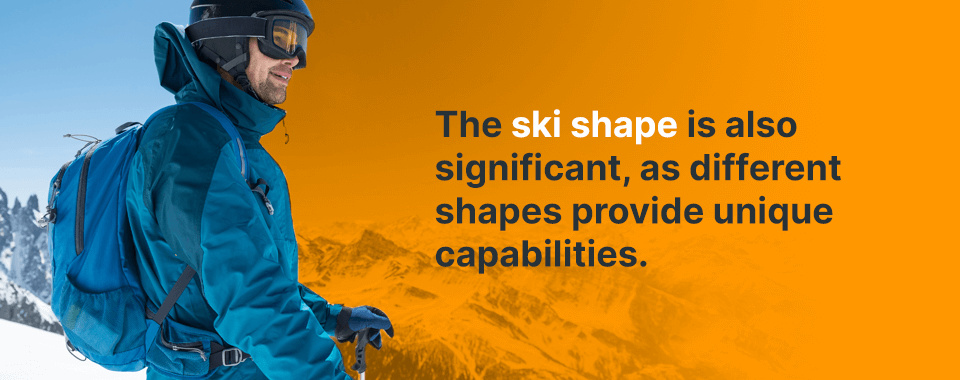
The ski shape is also significant, as different shapes provide unique capabilities. Shape options include:
- Traditional camber: "Camber" refers to the upward curve in the middle of a ski. A ski with a traditional camber profile offers stability in hard snow, propelling you through turns.
- Camber with tip rocker: The "rocker" is the curved rise on a ski's front or back end. Tip rockers can help you make turns more quickly.
- Camber with tip and tail rocker: A ski with this profile will have a lifted tip and tail end. Having two rockers makes for easier turn initiation and release.
- Full rocker with no camber: A "full rocker" ski has upward curves on both ends but not the middle. This type of ski works well in deep snow.
4. Gender
Be sure to check a ski's gender designation, which affects the waist width and length. Women's skis cater to the anatomical shape and weight distribution of a woman's body, offering narrower and shorter designs. Since women's skis are thinner and shorter, they require less weight to initiate movement. They'll be easier for a lighter and smaller-footed skier to use.
Keep in mind that you should still choose the waist width based on your size, weight, ability level and desire for maneuverability or float. There's no rule against women shopping in the men's section! Just remember that gender categories affect ski size and shape.
5. Ski Destination and Terrain
Where you plan on skiing will help you determine the type of skis best for you. Consider where you spend most of your time on the mountain. Do you regularly hit the backcountry? Or do you enjoy staying on-piste, carving the compact snow for an enjoyable ride?
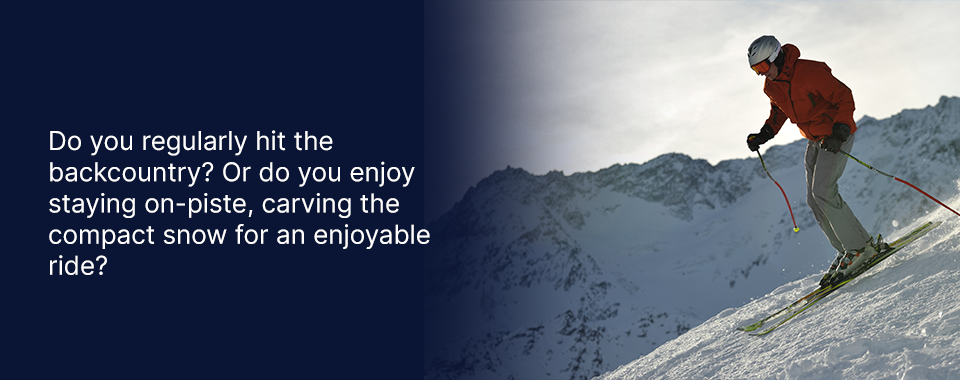
It's wise to choose your skis based on the destination and terrain you expect to enjoy most frequently, as it will ultimately impact the length and width of your skis. Consider the following ski categories before you purchase:
- All mountain: These skis are one of the most used options. Designed for skiers who plan on skiing the whole mountain, they can deal with various conditions, including ice, steeps, heavy snow and powder.
- Big mountain: If you're looking to hit big air and fly down steep lines, a pair of big mountain skis will help you perform in style.
- Freeride: Also known as powder skis, this type is ideal for spending days in the deep powder, out in the backcountry where the snow doesn't get any fresher.
- Alpine touring: Backcountry skis are lightweight options usually available in several sizes to help you on your treks through remote mountain landscapes.
- Piste: For those who love to carve down the mountain on a beautiful layer of groomed snow, you won't get any better than piste skis.
- Freestyle: Typically, these are shorter skis constructed to keep up with all the jumps, rails and jibs you'll find in a terrain park.
6. What Type of Skier are You?
Every skier has a unique style of shredding the mountain — just like skis. The pair you choose should match your personality, which determines how you ski the mountain and what kind of experience you're looking for.
Some skiers like to race to the bottom and carve turns on groomers, while others want to take their time to enjoy a confident ride. When deciding which ski is for you, ask yourself the following questions:
- Do you like going fast, or would you prefer a leisurely ride?
- Do you want to go off jumps and perform tricks?
- How often do you ski?
- How committed to skiing are you?
These questions will help you focus your search, matching you to the ideal ski based on your needs.
7. Utilize the Shop Employees' Expertise
Searching for new skis can be an intimidating endeavor, whether you're new to the game or a veteran with a worn-out pair. One of the best resources you can use is a ski shop employee. These professionals have the experience and knowledge to help you sort through the endless supply of options and find the perfect pair of skis.
Ask questions, have conversations and discover which options test well — ski shop employees can answer and address any question or concern, ready to uncover a hidden gem you haven't considered yet.
Shop the Season's Best Skis
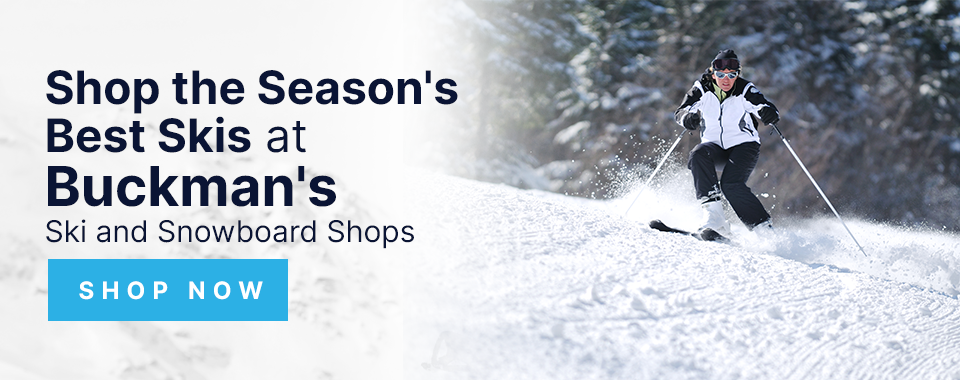
Whether you're a first-time skier or a veteran on the slopes, the right pair of skis elevates the experience and boosts your capabilities. When shopping for new skis, pay attention to the skill level, waist width, shape and gender designation. Stiffer skis are better for expert skiers who want to apply more force, skinnier skis are ideal for pre-cut trails and wider skis give you the floatation and stability to go off-trail. Additionally, various shapes serve different purposes.
If you're looking for next season's skis, consider browsing the selection at Buckman's Ski and Snowboard Shops. Here at Buckman's, we are passionate about skiing and snowboarding — we want to help you experience winter to its fullest. Check out our ski equipment today.
Categories:
Ski equipment